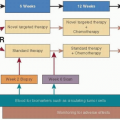history of breast cancer generally document that patients diagnosed with mammography detected only in-breast recurrences have superior survival to those with symptomatic recurrences (19, 20). These studies all suffer from being relatively small in sample size and are non-randomized. Thus, it is impossible to correct for confounding by lead-time and length-time biases.
with invasive breast cancer (27). At the time of analysis, 2,140 patients had experienced a relapse, 93 had a second non-breast primary tumor, and 111 had died without relapse during 10-years median follow-up. In this analysis, only alkaline phosphatase was abnormal in at least 20% of patients with recurrent disease, and was abnormal in 32% of patients with bone metastasis and 71% of patients with liver metastasis. Aspartate aminotransferase and γ-glutamyl transferase were elevated in 62% and 75% of patients with liver metastasis. Bilirubin, calcium, and creatinine were of no value in detecting recurrent disease. Thus, while alkaline phosphatase was the most reliable of the blood tests, it was of low sensitivity for bone or liver disease. In another study of 1,371 patients with node positive breast cancer, serial alkaline phosphatase determinations were found to have low sensitivity and specificity for bone recurrence (28). Thus, monitoring of routine blood tests as a part of breast cancer surveillance is not recommended.
TABLE 67-1 Location of First Recurrence in Randomized Trials of Intensive versus Routine Surveillance | ||||||||||||||||||||||||||||||||||||||||||||||||||||||||||||||||||
|---|---|---|---|---|---|---|---|---|---|---|---|---|---|---|---|---|---|---|---|---|---|---|---|---|---|---|---|---|---|---|---|---|---|---|---|---|---|---|---|---|---|---|---|---|---|---|---|---|---|---|---|---|---|---|---|---|---|---|---|---|---|---|---|---|---|---|
| ||||||||||||||||||||||||||||||||||||||||||||||||||||||||||||||||||
Stay updated, free articles. Join our Telegram channel

Full access? Get Clinical Tree







